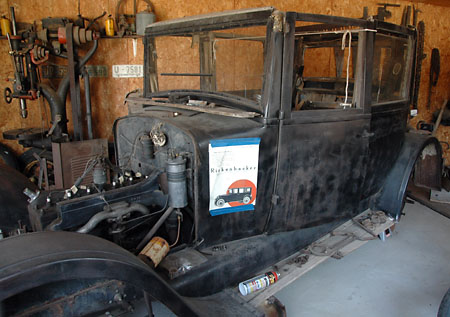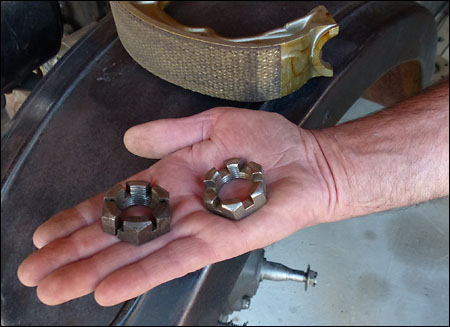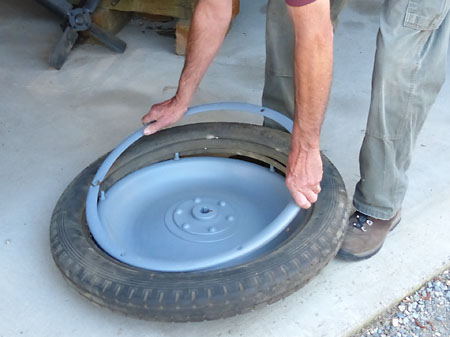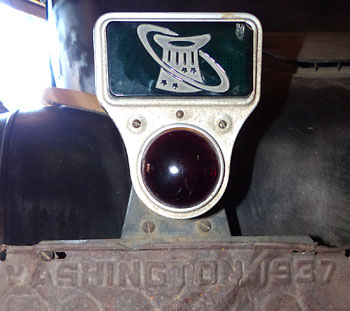home | internet service | web design | business directory | bulletin board | advertise | events calendar | contact | weather | cams

|
 John Owen holds an original Rickenbacker advertisement in front of the Shafer Museum’s own Rickenbacker. John Owen holds an original Rickenbacker advertisement in front of the Shafer Museum’s own Rickenbacker.
A very rare car sits in a shed at Winthrop’s Shafer Museum—a 1924 Rickenbacker coupe—and three local men are determined to restore it. The car is one of thirteen 1924 Rickenbackers known to still exist. Only five of those are coupes. “We were happy when we found this,” said local car enthusiast John Owen, in a serious understatement: he, Dick Roberts and Jeff Jones have been putting a lot of knowledge, muscle and research into their restoration project. “Last fall we actually ran the engine,” said Owen with a smile. “It purrs.” At 58 horsepower, the manufacturers claimed the Rickenbacker could run up to 60 miles per hour, a fast-moving car for that era. Rickenbakers were manufactured between 1922 and 1927, Owen said. But once the three ran the engine, they started to work over the whole car. “Now we’re tearing it down and cleaning it,” Owen said and “everything we do we find problems.” He and Jones are the main mechanics, while Roberts has been focusing on the wooden part of the automobile. One of their current skirmishes is about tires. The group works with local talent when they can: they tapped Barry Stromberger to sand-blast and prime the wheels. That’s done, and done well, Owen said. Now they have to find tires to fit. The tire is just supposed to stretch and slide onto the wheel, and then a retaining ring is attached. But so far, they’ve been skunked. “I’ve been in touch with three tire companies,” said Owen. “They all swear what they sent fits, but it doesn’t.”  After getting the engine to run the group began tearing down and cleaning the vintage vehicle at the Shafer Museum. After getting the engine to run the group began tearing down and cleaning the vintage vehicle at the Shafer Museum.Owen thinks he has a solution in a member of the Rickenbacker Automobile Club of America—Shirley Young of Canal Winchester, Ohio. She and her husband, Lloyd, “have a Rickenbacker the same model and year as ours” among the “33 antique cars in their barn.” The Shafer Museum is one of the 70 members of the club and Owen and his cohorts have been communicating with Young, who is a representative of a tire company. They believe that she will help by working with her company to come through with tires that actually fit on the Shafer Museum Rickenbacker. The Rickenbacker chassis is steel, the body is aluminum, and each wheel has its own brake. The aluminum brake shoes were cracked. Again the restorers found local expertise: Mike Sands, an aluminum welder, restored the brake shoes beautifully, Owen said.  John Owen was struggling to find a replacement, from another Rickenbacker somewhere, for a broken rear axle nut (left). Then he happened to mention his effort to a man at Hamilton Farm Equipment in Okanogan. “He got interested, went in back and came back with this $11 nut,” Owen laughed. The nut fits. John Owen was struggling to find a replacement, from another Rickenbacker somewhere, for a broken rear axle nut (left). Then he happened to mention his effort to a man at Hamilton Farm Equipment in Okanogan. “He got interested, went in back and came back with this $11 nut,” Owen laughed. The nut fits.“The frame that held the body together is wood,” said Owen. “Dick Roberts is developing the patterns” and carefully restoring the woodwork, laboriously “piece by piece,” hand-carving oak to replace the lost parts of the frame. “We know she’ll run,” Owen said. “The question is how much of a restoration we’ll do.” Do they leave the marks and patina of its earlier life in place, or do they make it appear like new? The car was retro-fit with an electric starter a long time ago. Nobody has to risk breaking their arm by hand-cranking the engine to start it. Owen demonstrated proper cranking technique: he stands on one side of the Rickenbacker facing the crank with his right shoulder towards the car. He grabs the crank with the fingers of his right hand, not wrapping his thumb over the crank. If the crank kicks back, it just pulls away from his fingers, not getting caught in the firmer grasp offered when the thumb is used also. The crank travels half of a circle. Starting at about 9:00 he yanks the handle—hard—clockwise up and over the top then down to about 3:00 and lets go. The restorers spend plenty of time researching and hunting down parts. Rickenbacker Club President Roland Klix has been an enormous help with that, Owen said. Klix has even had a mold made from an existing Rickenbacker brass door handle. Owen is searching now for a way to get new handles cast in the mould. He said Klix told him “if you do that, I’m sure we can sell it.”  Owen demonstrates how a rim holds a tire on the Rickenbacker wheel, which was cleaned and painted by local metal worker Barry Stromberger. Owen demonstrates how a rim holds a tire on the Rickenbacker wheel, which was cleaned and painted by local metal worker Barry Stromberger.The car’s “history is kind of unknown,” said Owen. “It came from a couple in Waterville,” but the three don’t know who, and they would love to. Owen’s best guess is that it rode to Winthrop on Simon Shafer’s truck in the 1940’s. “He acquired it for his museum,” Owen said, along with a Model T he bought around the same time. The Rickenbacker cost $1,885 new. That was mid-priced at the time: a Model T was under $1,000. The Rickenbacker boasted a six-cylinder engine with two fly-wheels, which made it run smoothly, and a low center of gravity, which made it more stable. The Rickenbacker name was originally spelled Rickenbacher, but Eddie Rickenbacher, a Swiss-American, did not want people to think that he was German during World War I, so he changed the spelling. He did more than that: he came home to the United States with “the French Legion of Honor, the Croix de Guerre and three citations, and the American Distinguished Service Cross,” according to an article by Beverly Rai Kimes in a 1975 edition of Automobile Quarterly. He shot down 26 German aircraft in combat, and he was a larger-than-life war hero, a fact he and his partners used to market Rickenbacker cars once they started to manufacture them.  The ‘Hat in the Ring’ insignia of the WWI squadron of Captain Eddie RIckenbacker became the car company’s emblem. The ‘Hat in the Ring’ insignia of the WWI squadron of Captain Eddie RIckenbacker became the car company’s emblem.“One urban legend says (the Shafer Museum Rickenbacker) was all together and ran in the 1970’s,” Owen said, but “we can’t find any old photos” of it, or any way, so far, to prove or disprove the legend. Search, research, improvise, struggle, pry, weld, cut and scrape: Owen, Jones and Roberts are spending a lot of time at the Shafer Museum. “We’re scratching our heads,” Owen said, “but it’s all a fun battle.” 8/10/2013 Comments
|
